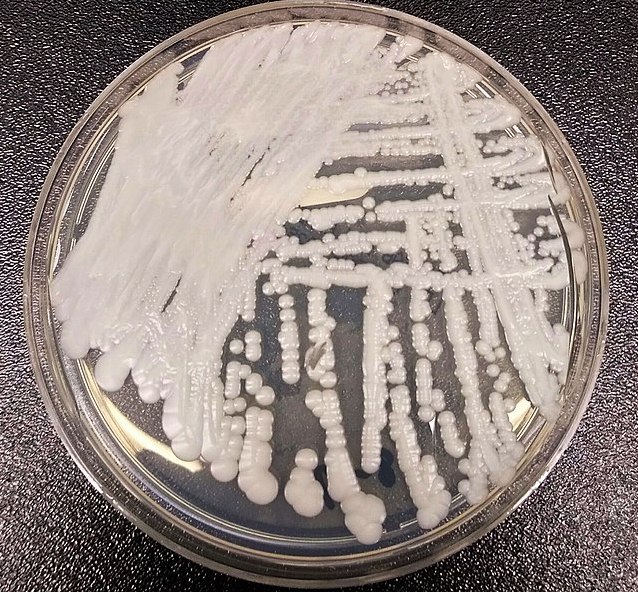 CDC reports an increase in the spread of the deadly Candida auris fungus in the USA. Credit: Shawn Lockhart / Wikimedia Commons / Public Domain.
CDC reports an increase in the spread of the deadly Candida auris fungus in the USA. Credit: Shawn Lockhart / Wikimedia Commons / Public Domain.A fungal infection known as Candida auris (C. auris) has become a pressing antimicrobial resistance (AR) threat, as per the Centers for Disease Control and Prevention (CDC) data published in the Annals of Internal Medicine.
The fungus spread rapidly in U.S. healthcare facilities during 2020-2021, and there has been a threefold increase in the number of cases resistant to echinocandins in 2021. Echinocandins are the most recommended antifungal medication for treating C. auris infections.
However, this emerging fungus is not typically a threat to healthy individuals. People who are critically ill, have invasive medical devices or have extended or frequent stays in healthcare facilities are at higher risk of contracting C. auris.
The CDC has identified C. auris as an urgent AR threat due to its propensity for resisting multiple antifungal drugs, quick spread in healthcare facilities, and potential for causing severe infections with high fatality rates.
The swift surge and geographic expansion of C. auris cases are alarming, according to Dr. Meghan Lyman, lead author of the paper and a CDC epidemiologist.
Therefore, it is essential to have constant monitoring, increased laboratory capacity, prompt diagnostic tests, and strict adherence to proven infection prevention and control measures, said Dr. Lyman.
Deadly fungal infection spreading at an alarming rate CDC says:
A drug-resistant and potentially deadly fungus has been spreading rapidly through U.S. health care facilities, a new government study finds. The fungus can cause severe illness in people with weakened immune systems pic.twitter.com/lLHd1TVVfp
— Dr. Jeff Rabinowitz (VotedBlueIn2022) 🇺🇦 (@rxjef77) March 21, 2023
First reporting of Candida Auris
The prevalence of Candida auris (C. auris) in the United States was first reported in 2016. As of December 31, 2021, there had been a total of 3,270 clinical cases, and 7,413 screening cases reported, where the fungus was detected but not causing an infection.
During the period of 2019-2021, 17 states in the country identified their first C. auris case. Nationally, the number of clinical cases jumped from 476 in 2019 to 1,471 in 2021, while screening cases tripled from 2020 to 2021, reaching a total of 4,041, according to CDC.
Reasons for the rapid spread of C. auris
One of the leading causes of this increase can be attributed to inadequate infection prevention and control (IPC) measures in healthcare establishments, according to CDC.
Additionally, the augmentation in case counts can be attributed to the escalation of screening efforts, including colonization screening, a diagnostic test that can detect the presence of the fungus on an individual’s body, even in the absence of an active infection or related symptoms.
The current timing of this uptick, coupled with the results of recent public health investigations, suggests that the spread of C. auris may have been further exacerbated due to the overwhelming burden that the COVID-19 pandemic has placed on the healthcare and public health systems, CDC mentioned.
Yesterday the CDC said a deadly fungus, Candida Auris, spread at an “alarming rate” during the pandemic. The fungus preys on older people with weak immune systems, resists treatment by antifungal medications. Those in nursing homes and hospitals on ventilators are most at risk. pic.twitter.com/NfSAYyeXFo
— George Masterson CPA (@GMastersonCPA) March 21, 2023
CDC’s response to rising in C. auris spread
The CDC’s Antimicrobial Resistance Laboratory Network plays a crucial role in detecting antimicrobial resistance and preventing its spread.
Recently, this network has provided important data for a new report. The CDC has taken steps to improve lab capacity across the nation, including in state, territorial, and local health departments, thanks to supplemental funding from the American Rescue Plan Act.
As part of these efforts, susceptibility testing capacity for C. auris has been expanded from just seven Regional Labs to more than 26 labs nationwide.
Despite these improvements, C. auris remains a serious threat to public health. To combat this emerging danger, the CDC says it is collaborating with state, local, and territorial health departments as well as other partners.

 1 year ago
69
1 year ago
69











 English (US)
English (US)